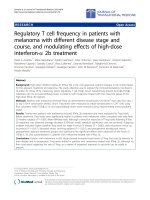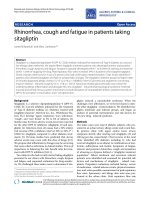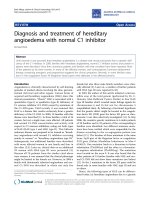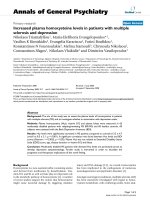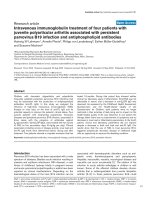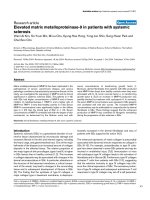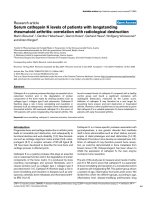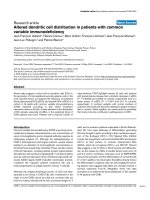Báo cáo y học: "Altered dendritic cell distribution in patients with common variable immunodeficiency" pot
Bạn đang xem bản rút gọn của tài liệu. Xem và tải ngay bản đầy đủ của tài liệu tại đây (153.96 KB, 4 trang )
Open Access
Available online />R1052
Vol 7 No 5
Research article
Altered dendritic cell distribution in patients with common
variable immunodeficiency
Jean-François Viallard
1
, Fabrice Camou
1
, Marc André
2
, François Liferman
3
, Jean-François Moreau
4
,
Jean-Luc Pellegrin
1
and Patrick Blanco
4
1
Department of Internal Medicine and Infectious Diseases, Haut-Lévêque Hospital, Pessac, France
2
Department of Internal Medicine, Gabriel-Montpied Hospital, Clermont-Ferrand, France
3
Department of Internal Medicine, Dax Hospital, Dax, France
4
Laboratory of Immunology, Pellegrin Hospital, Bordeaux, France
Corresponding author: Jean-François Viallard,
Received: 14 Jan 2005 Revisions requested: 17 Feb 2005 Revisions received: 23 May 2005 Accepted: 1 Jun 2005 Published: 1 Jul 2005
Arthritis Research & Therapy 2005, 7:R1052-R1055 (DOI 10.1186/ar1774)
This article is online at: />© 2005 Viallard et al.; licensee BioMed Central Ltd.
This is an Open Access article distributed under the terms of the Creative Commons Attribution License ( />2.0), which permits unrestricted use, distribution, and reproduction in any medium, provided the original work is properly cited.
Abstract
Recent data suggest a critical role for dendritic cells (DCs) in
the generation of immunoglobulin-secreting plasma cells. In the
work reported herein, we analyzed the frequency of peripheral
blood plasmacytoid DCs (pDCs) and myeloid DCs (mDCs) in a
cohort of 44 adults with common variable immunodeficiency
(CVID) classified according to their CD27 membrane
expression status on B cells. A deep alteration in the distribution
of DC subsets, especially of pDCs, in the peripheral blood of
CVID patients was found. Patients with a reduced number of
class-switched CD27
+
IgD
-
IgM
-
memory B cells and patients
with granulomatous disease had a dramatic decrease in pDCs
(P = 0.00005 and 0.0003 vs controls, respectively) and, to a
lesser extent, of mDCs (P = 0.001 and 0.01 vs controls,
respectively). In contrast, patients with normal numbers of
switched memory B cells had a DC distribution pattern similar to
that in controls. Taken together, our results raise the possibility
that innate immunity contributes to pathogenesis in CVID.
Introduction
Common variable immunodeficiency (CVID) is a primary immu-
nodeficiency disease characterized by a low concentration of
serum immunoglobulins and an impaired antibody response to
challenging antigens [1]. Although the pathophysiology of
CVID is heterogeneous and largely unknown, several causes
leading to an alteration of immunoglobulin concentrations in
the blood have already been identified. These include a failure
of B-cell maturation, including altered somatic hypermutation
[2]; defective cell-membrane signaling [3]; T-cell abnormalities
such as reduced expression of key membrane-expressed mol-
ecules (CD40 ligand, ICOS (inducible costimulator protein),
L-selectin) [4]; impaired cytokine production [5]; and a
reduced generation of antigen-specific memory T cells [6].
Whereas the antigen-presenting function of DCs has been
reported to be normal in CVID [7,8], their involvement in the
origin of some CVID cannot be ruled out, as these cells are
known to interact directly with B cells, to present antigen to T
cells, and to produce cytokines implicated in B-cell differenti-
ation [9]. Two major pathways of differentiation generating
DCs are thought to exist, according to their membrane expres-
sion of the β-integrin CD11c [10]. Myeloid DCs (mDCs)
include skin Langerhans' cells and interstitial DCs and express
CD11c at their surface. In contrast, plasmacytoid DCs
(pDCs), which do not express CD11c, are CD123
+
. Recent
data suggest a role for DCs in B-cell growth and differentia-
tion, as the release by mDCs of soluble factors such as IL-12
and IL-6 and/or membrane molecules such as BAFF/APRIL
induces the activation and the differentiation of normal B cells
[11,12]. In addition, the observation that pDCs directly induce
the differentiation of plasma cells into immunoglobulin-secret-
ing plasma cells suggests that pDCs are critically involved in
humoral responses [13,14]. Altogether, these new data
prompted us to examine the blood distribution of DC subsets
in 44 patients with CVID.
CVID = common variable immunodeficiency; Ig = immunoglobulin; IL = interleukin; mDC = myeloid dendritic cell; pDC = plasmacytoid dendritic cell.
Arthritis Research & Therapy Vol 7 No 5 Viallard et al.
R1053
Materials and methods
Patient characteristics
Forty-four patients with CVID (17 to 77 years of age; 28
women and 17 men) were enrolled in this study after they had
given their informed consent and following the approval of the
local Ethics Committee. All patients were diagnosed as having
CVID, on the basis of a specific medical history of recurrent
bacterial infections associated with hypogammaglobulinemia
(serum immunoglobulin (Ig)G and IgA and/or IgM at least two
standard deviations below the normal mean) [15]. At the time
of evaluation, none of the patients showed evidence of acute
infection. As is frequently observed in CVID, 13 of the 45
patients had autoimmune diseases, 14 had splenomegaly, 5
had lymphoid hyperplasia, and 7 presented with a chronic
granulomatous disease.
All the patients included in this study had blood CD19
+
CD3
-
B-lymphocyte counts above 1% of peripheral blood lym-
phocytes. The CVID patients were divided into two groups
according to the detection of switched memory B cells
(CD27
+
IgD
-
) as recently proposed by Warnatz and colleagues
[16]. Group 1 (n = 22), comprising patients whose proportion
of switched memory B cells was less than 0.4% of their total
peripheral blood lymphocytes, was further subdivided accord-
ing to whether they had increased (group 1a; n = 13) or nor-
mal (group 1b; n = 9) numbers of CD19
+
CD21
-
immature B
cells. Group 2 (n = 15) comprised patients whose proportion
of switched memory B cells was more than 0.4% of total
peripheral blood lymphocytes. As Warnatz and colleagues
excluded from their classification patients with granulomatous
disease, we classified these patients in a distinct group (group
3; n = 7). Control patients were healthy Caucasian blood
donors and health-care workers (n = 12, median 36 years; 8
women and 4 men); they were not matched with patients for
sex or age.
Quantitation of blood DC precursors by flow cytometry
DC subsets were measured using the DC kit purchased from
BD Biosciences (Pont-de-Claix, France). Samples were ana-
lyzed on a FACSCalibur flow cytometer (BD Biosciences) and
10
6
white blood cells were acquired. Peripheral blood mDC
and pDC subsets were defined by the concomitant lack of lin-
eage markers, HLA-DR expression, and mutually exclusive
membrane expression of CD11c or CD123, respectively.
Absolute numbers of blood DC precursor subsets were calcu-
lated as percentage of white blood cells or expressed per ml
of peripheral blood. Membrane expression of chemokine
receptors was assessed by flow cytometry using a triple com-
bination of monoclonal antibodies: BDCA2-FITC (Miltenyi Bio-
tec, Paris, France); and HLA-DR-PerCp; and CCR2-PE or
CCR5-PE or CCR7-PE or CXCR3-PE or CXCR4-PE (BD
Biosciences).
Statistical analysis
Median values found for blood cells were compared between
groups using the nonparametric Mann–Whitney U test, with a
level of significance of P = 0.05. The Spearman test was used
to make correlations. The tests were performed with the statis-
tical software Statistica Inc (Statsoft, Tucson, AZ, USA).
Results and discussion
The median absolute count of circulating pDCs was signifi-
cantly lower in CVID patients than in controls (P = 0.002).
Although CVID patients had a lower mean mDC count, their
median absolute count was not statistically significantly differ-
ent from that of controls (P = 0.1) (Fig. 1).
Table 1
Absolute counts of peripheral blood DCs in controls and in patients with CVID
Dendritic cells per ml Healthy controls (n = 12) CVID patients
a
Group 1a (n = 13) Group 1b (n = 9) Group 2 (n = 15) Group 3 (n = 7)
Myeloid DCs
Total (median) 14,361 8,432*,
θ
13,475 15,267 5,568
Ψ,φ
Percentiles (25th, 75th) 11,470, 16,693 1,428, 11,330 8,378, 16,143 9,462, 18,590 4,315, 11,100
Range 8,941–22,204 342–21,895 3,039–19,385 6,178–28,472 3,787–22,994
Plasmacytoid DCs
Total pDCs (median) 9,829 2,367*,
λ,θ
3,647 8,980 1,403
Ψ,ξ,φ
Percentiles (25th, 75th) 8,366, 16,555 353, 5,012 2,532, 11,590 4,096, 13,367 661, 2,448
Range 7,514–22,769 19–8,291 2,004–13,714 1,614–25,725 417–4,917
a
Patients were grouped according to whether their proportion of switched memory B cells was <0.4% (groups 1a, 1b) or >0.4% (group 2) of total
peripheral blood lymphocytes or they had granulomatous disease (group 3). Group 1 was subdivided according to whether numbers of
CD19
+
CD21
-
immature B cells were increased (group 1a) or normal (group 1b). *P < 0.001 vs controls;
θ
P < 0.009 vs group 2;
λ
P = 0.02 vs
group 1b;
Ψ
P < 0.01 vs controls;
ξ
P < 0.009 vs group 1b;
φ
P < 0.02 vs group 2. Other comparisons between each population were not
statistically significant. The nonparametric Mann–Whitney U test was used for comparisons. CVID, common variable immunodeficiency.
Available online />R1054
However, when CVID patients were segregated in accord-
ance with the Warnatz classification, the DC subset distribu-
tions were quite different between groups (Table 1). Groups
1a and 3 had statistically significantly lower levels of circulat-
ing DCs of both types than controls, but this difference was far
more dramatic concerning the pDC subset (P = 0.001 and P
= 0.01 for mDCs and P = 0.00005 and 0.0003 for pDCs,
respectively). In groups 1b and 2, blood pDCs and mDCs
were not statistically different in comparison with those in
controls.
When the various groups of CVID patients were compared
with each other, the median absolute count of circulating
mDCs was found to be significantly reduced in groups 1a and
3 vs group 2 (P = 0.009 and P = 0.02, respectively).
Although the median values of mDCs were lower in group 1a
than in group 1b, the difference did not reach statistical signif-
icance (P = 0.1). In contrast, CVID patients in groups 1a and
3 had significantly lower pDCs median counts than those in
group 2 (P = 0.0005 and P = 0.001, respectively), and, to a
lesser extent, in group 1b (P = 0.02 and P = 0.009). No dif-
ferences were observed between group 1a and group 3.
Moreover, we found a significant inverse statistical correlation
between the low peripheral pDC levels of 19 CVID patients
and the expression of the chemokine receptor CCR7 (R = -
2.31, P = 0.03, Spearman test). These 19 patients were fol-
lowed in the Department of Internal Medicine at Haut-Lévêque
Hospital, directed by JL Pellegrin and JF Viallard. They were
chosen because blood samples could easily be taken, in con-
sideration of the short time-period available to perform new
experiments with chemokine receptors. Of these 19 patients,
5 belonged to group Ia, 5 to group Ib, 6 to group II and 3 to
group III. No differences were observed between the different
groups with regard to the expression of other chemokine
receptors including CCR2, CCR5, CXCR3, and CXCR4. This
observation is in agreement with the already published data
concerning the CCL19- and CCL21-dependent migration of
mature pDCs to lymph nodes [17].
The most salient feature of the present study concerns
patients in group 1a, who were at higher risk of autoimmune
diseases (10 of 13 patients) and splenomegaly (9 of 13), and
in group 3, both groups exhibiting a marked decrease in their
peripheral pDC levels. Patients in group 2, who did not
develop such complications, were similar to healthy
individuals.
From these preliminary observations we can only speculate on
the diminished pDC counts observed in the patients of groups
1a and 3. The migratory properties of DCs seem to be altered,
leading to sequestration in tissue and/or secondary lymphoid
organs due to an alteration of chemokine receptor membrane
expression and maturation. However, we cannot rule out a
defect in their function, such as has been suggested regarding
DCs derived in vitro from monocytes [18].
At least in some patients, hypogammaglobulinemia could rely
on an alteration of the innate immunity, since pDCs seem to
play a critical role in the generation of antibody responses:
they have been shown in vitro to control the differentiation of
activated B cells into plasma cells through the secretion of
interferon α and β and of IL-6 [13]. B cells activated with pDCs
preferentially secrete IgG over IgM, suggesting that pDCs may
specifically target memory B cells, whereas mDCs, which can
enhance B-cell proliferation and isotype switching toward IgA
[19], as well as plasma cell differentiation [20], could induce
the differentiation of naive B cells through the secretion of IL-
12 and IL-6 [11]. Granulocyte-colony-stimulating factor and
FLT3 ligand, through their ability to mobilize dendritic cells,
may be a new and valuable therapeutic alternative for CVID
patients.
Conclusion
Our data provide evidence of a profound alteration in the dis-
tribution of subsets of DCs, especially pDCs, in the peripheral
blood of CVID patients. Taken together, our results raise the
possibility that innate immunity is involved in CVID
pathogenesis.
Competing interests
The authors declare that they have no competing interests.
Figure 1
Absolute counts of pDcs and mDCs in 45 CVID patients and 12 controlsAbsolute counts of pDCs and mDCs in 45 CVID patients and 12 con-
trols. Medians of absolute counts of peripheral blood lymphoid den-
dritic cells (pDCs) (white boxes; ᮀ) and myeloid DCs (shaded boxes;
∆) in 12 control subjects (respective median values, 9,829/ml and
14,361/ml; extreme values, 7,514 to 22,769/ml and 8,941 to 22,204/
ml) and 44 patients with common variable immunodeficiency (CVID)
(respective median values, 3,647/ml and 11,100/ml; extreme values,
19 to 22,144/ml and 342 to 28,472/ml). The symbol within each box
represents the median value. The upper and lower edges of the boxes
represent the 25th and 75th percentiles, and the bars on the whiskers
represent the 10th and 90th percentiles. ᭺ represents an aberrant
value. Statistical comparisons between the two populations (nonpara-
metric Mann–Whitney U test): P = 0.002 for pDCs and P = 0.1 for
mDCs.
Arthritis Research & Therapy Vol 7 No 5 Viallard et al.
R1055
Authors' contributions
JFV and FC were in charge of most of the CVID patients gath-
ered in this study, performed the statistical analysis, analyzed
the data, and contributed to the writing of the article. PB put
together the data, supervised the laboratory examinations,
analyzed the data, and contributed to the writing of the article.
JFM analyzed the data, participated in the laboratory examina-
tions, contributed to the editing of the article, and supervised
the research group. JLP was, along with JFV, in charge of most
of the CVID patients gathered in this study and contributed to
the writing of the article. MA and FL were in charge of CVID
patients and contributed to the writing and preparation of the
article. All authors read and approved the final manuscript.
Acknowledgements
We are indebted to and would like to thank Ms N Berrie, Ms F Saussais,
and Mr JC Carron for their skillful technical performance of flow cytomet-
ric analysis in the routine laboratory of the Bordeaux University Hospital.
We would also like to thank Gabriel Etienne, Philippe Morlat, and Maïté
Longy-Boursier (Saint-André Hospital, Bordeaux), Didier Neau (Pel-
legrin Hospital, Bordeaux), Laurence Baillet (Haut-Lévêque Hospital,
Pessac), Elisabeth Vidal (Dupuytren Hospital, Limoges) and Olivier
Aumaître (Gabriel-Montpied Hospital, Clermont-Ferrand) who all were in
charge of CVID patients.
References
1. Cunningham-Rundles C, Bodian C: Common variable immuno-
deficiency: clinical and immunological features of 248
patients. Clin Immunol 1999, 92:34-48.
2. Levy Y, Gupta N, Le Deist F, Garcia C, Fischer A, Weill JC, Rey-
naud CA: Defect in IgV gene somatic hypermutation in com-
mon variable immuno-deficiency syndrome. Proc Natl Acad
Sci USA 1998, 95:13135-13140.
3. Eisenstein EM, Strober W: Evidence for a generalized signaling
abnormality in B cells from patients with common variable
immunodeficiency. Adv Exp Med Biol 1995, 371B:699-704.
4. Grimbacher B, Hutloff A, Schlesier M, Glocker E, Warnatz K,
Drager R, Eibel H, Fischer B, Schaffer AA, Mages HW, et al.:
Homozygous loss of ICOS is associated with adult-onset
common variable immunodeficiency. Nat Immunol 2003,
4:261-268.
5. Pastorelli G, Roncarolo MG, Touraine JL, Peronne G, Tovo PA, de
Vries JE: Peripheral blood lymphocytes of patients with com-
mon variable immunodeficiency (CVI) produce reduced levels
of interleukin-4, interleukin-2 and interferon-gamma, but pro-
liferate normally upon activation by mitogens. Clin Exp
Immunol 1989, 78:334-340.
6. Kondratenko I, Amlot PL, Webster AD, Farrant J: Lack of specific
antibody response in common variable immunodeficiency
(CVID) associated with failure in production of antigen-spe-
cific memory T cells. MRC Immunodeficiency Group. Clin Exp
Immunol 1997, 108:9-13.
7. Thon V, Eggenbauer H, Wolf HM, Fischer MB, Litzman J, Lokaj J,
Eibl MM: Antigen presentation by common variable immuno-
deficiency (CVID) B cells and monocytes is unimpaired. Clin
Exp Immunol 1997, 108:1-8.
8. Fischer MB, Hauber I, Wolf HM, Vogel E, Mannhalter JW, Eibl MM:
Impaired TCR signal transduction, but normal antigen presen-
tation, in a patient with common variable immunodeficiency.
Br J Haematol 1994, 88:520-526.
9. Banchereau J, Briere F, Caux C, Davoust J, Lebecque S, Liu YJ,
Pulendran B, Palucka K: Immunobiology of dendritic cells. Annu
Rev Immunol 2000, 18:767-811.
10. Liu YJ: Dendritic cell subsets and lineages, and their functions
in innate and adaptive immunity. Cell 2001, 106:259-262.
11. Dubois B, Massacrier C, Vanbervliet B, Fayette J, Briere F,
Banchereau J, Caux C: Critical role of IL-12 in dendritic cell-
induced differentiation of naive B lymphocytes. J Immunol
1998, 161:2223-2231.
12. MacLennan I, Vinuesa C: Dendritic cells, BAFF, and APRIL:
innate players in adaptive antibody responses. Immunity 2002,
17:235-238.
13. Jego G, Palucka AK, Blanck JP, Chalouni C, Pascual V,
Banchereau J: Plasmacytoid dendritic cells induce plasma cell
differentiation through type I interferon and interleukin 6.
Immunity 2003, 19:225-234.
14. Poeck H, Wagner M, Battiany J, Rothenfusser S, Wellisch D, Hor-
nung V, Jahrsdorfer B, Giese T, Endres S, Hartmann G: Plasma-
cytoid dendritic cells, antigen, and CpG-C license human B
cells for plasma cell differentiation and immunoglobulin pro-
duction in the absence of T-cell help. Blood 2004,
103:3058-3064.
15. Conley ME, Notarangelo LD, Etzioni A: Diagnostic criteria for pri-
mary immunodeficiencies. Representing PAGID (Pan-Ameri-
can Group for Immunodeficiency) and ESID (European
Society for Immunodeficiencies). Clin Immunol 1999,
93:190-197.
16. Warnatz K, Denz A, Drager R, Braun M, Groth C, Wolff-Vorbeck G,
Eibel H, Schlesier M, Peter HH: Severe deficiency of switched
memory B cells (CD27(+)IgM(-)IgD(-)) in subgroups of
patients with common variable immunodeficiency: a new
approach to classify a heterogeneous disease. Blood 2002,
99:1544-1551.
17. Penna G, Sozzani S, Adorini L: Cutting edge: selective usage of
chemokine receptors by plasmacytoid dendritic cells. J
Immunol 2001, 167:1862-1866.
18. Bayry J, Lacroix-Desmazes S, Kazatchkine MD, Galicier L, Lepelle-
tier Y, Webster D, Lévy Y, Eibl MM, Oksenhendler E, Hermine O,
Kaveri SV: Common variable immunodeficiency is associated
with defective functions of dendritic cells. Blood 2004,
104:2441-2443.
19. Fayette J, Dubois B, Vandenabeele S, Bridon JM, Vanbervliet B,
Durand I, Banchereau J, Caux C, Briere F: Human dendritic cells
skew isotype switching of CD40-activated naive B cells
towards IgA1 and IgA2. J Exp Med 1997, 185:1909-1918.
20. Fayette J, Durand I, Bridon JM, Arpin C, Dubois B, Caux C, Liu YJ,
Banchereau J, Briere F: Dendritic cells enhance the differentia-
tion of naive B cells into plasma cells in vitro. Scand J Immunol
1998, 48:563-570.

